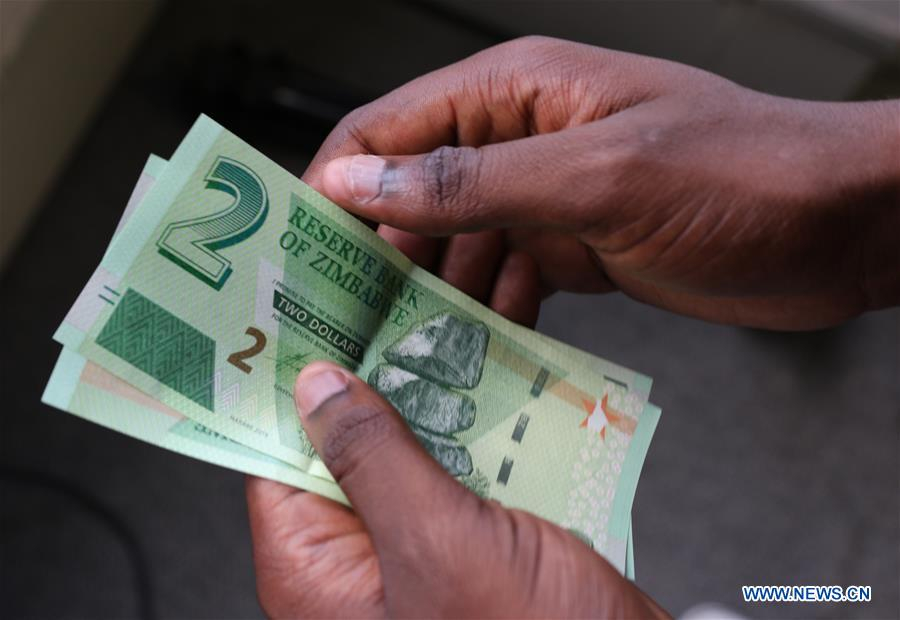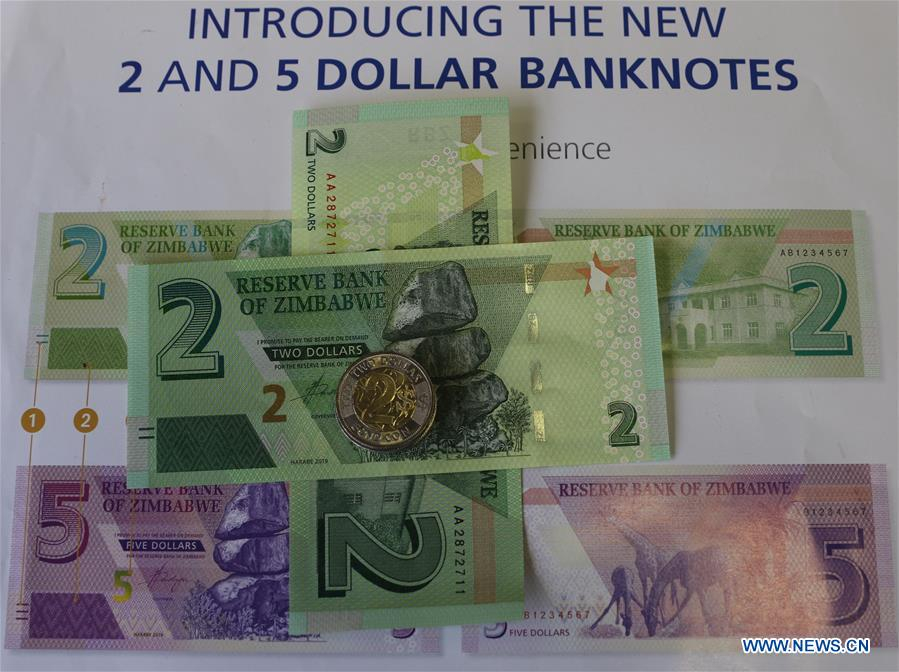
People queue to withdraw new bank notes in the Zimbabwean capital of Harare, November 12, 2019. /Shaun Jusa for Xinhua
People queue to withdraw new bank notes in the Zimbabwean capital of Harare, November 12, 2019. /Shaun Jusa for Xinhua
Zimbabwe introduced new Zimbabwean dollar bank notes this week in a bid to help tackle a cash shortage in the country. The Reserve Bank of Zimbabwe's move marked the first time in a decade that the currency has been issued.
Distributed to banks on Monday, the new small denomination notes of two and five dollars, as well as a two dollar coin, made it into the hands of queuing bank customers in the southern African country by Tuesday.
A 'relief' to withdraw money
Bank customer Rose Chipambwa was elated to withdraw the new notes but lamented the low cash withdrawal limit at her bank of 50 dollars per week, despite the Zimbabwean central bank's maximum weekly restriction of 300 dollars, Xinhua reported.
"It was quite a relief to walk in the banking hall and withdraw my money. There was no queue at all. I was happy to get the few dollars but the bank must increase the withdrawal limit," she said.
One billion Zimbabwean dollars are to be gradually fed into the economy over the coming six months to curtail fueling inflation.
A teller at a commercial bank said they expected to increase the withdrawal limit if they continued to get constant cash supplies from the central bank, according to Xinhua.

Zimbabwe's new two dollar notes, pictured on November 12, 2019. /Shaun Jusa for Xinhua
Zimbabwe's new two dollar notes, pictured on November 12, 2019. /Shaun Jusa for Xinhua
But there have been some instances of foul play. Photos of stashes of the new currency have been circulating on social media, inducing the Reserve Bank of Zimbabwe to source these images to the relevant commercial banks, who are now working with the police to investigate the cases. In one instance, a "plastic bin container full of bond coins" was traced to a CBZ Bank customer who withdrew 44,180 Zimbabwean dollars, according to a press statement from the Reserve Bank of Zimbabwe.
Zimbabwe's troubling annual budget
Following the central bank's initiative came troubling economic news from the Ministry of Finance and Economic Development with the publication of its 2020 budget.
Zimbabwe's economy is expected to shrink by 6.5 percent in 2019, a figure revised downwards from a previously anticipated 3 percent growth.
Inflation, which the country has infamously struggled with, saw double digit fluctuations in month-on-month figures. According to the International Monetary Fund in September, year-on-year inflation for August 2019 was almost 300 percent.

Bank customers await the new currency in Harare, Zimbabwe, November 12, 2019. /Shaun Jusa for Xinhua
Bank customers await the new currency in Harare, Zimbabwe, November 12, 2019. /Shaun Jusa for Xinhua
External factors such as an ongoing severe drought in the country and the destruction wrought by Cyclone Idai earlier this year are thought to have compounded the country's economic woes.
Reforming the Zimbabwean economy has been "very painful," the Ministry of Finance's budget document said. Ordinary Zimbabweans have seen their socio-economic conditions deteriorate as they " bear the brunt of low growth, high inflation, rising unemployment and low wages."
Nonetheless, the Zimbabwean finance ministry projected that the country's economy will grow by three percent in 2020, a significant jump on the domestic front but still below the anticipated emerging market average of 4.6 percent.
Notes 'abandoned on the street'
Zimbabwe has employed the use of multiple currencies in recent history, including U.S. dollars, so-called bond notes that were introduced in 2016 and intended to be equivalent in value to the U.S. dollar, and an electronic currency. Zimbabwean dollars were scrapped in 2009 after losing value due to hyperinflation. But the use of foreign currencies in the country was abolished earlier this year.

Zimbabwe's new two and five dollar notes and a two dollar coin, pictured on November 12, 2019. /Shaun Jusa for Xinhua
Zimbabwe's new two and five dollar notes and a two dollar coin, pictured on November 12, 2019. /Shaun Jusa for Xinhua
"The government of Zimbabwe has been desperate to regain control of its money. Hyperinflation destroyed its currency in 2008, with notes literally abandoned on the street," Martin Plaut, senior research fellow at the Council on Foreign Relations told CGTN on Friday.
"But given the government's track record of printing money and devaluing the currency there can be little confidence that (the latest measures) will see a return to normality or economic stability," he added.
Restricted mobile payments
Mobile payments, part and parcel of daily life in China and increasingly adopted by African countries, have also been incorporated into the Zimbabwean central bank's drive to control its cash.
The Reserve Bank of Zimbabwe put a stop to cash payments in and out of mobile money platforms in late September.
The country's cash shortage meant that agents were charging premiums of up to 50 percent, Xinhua reported.
Zimbabwe's central bank released statement a few days later saying that cash withdrawals were now permitted but had been capped at 100 Zimbabwean dollars.